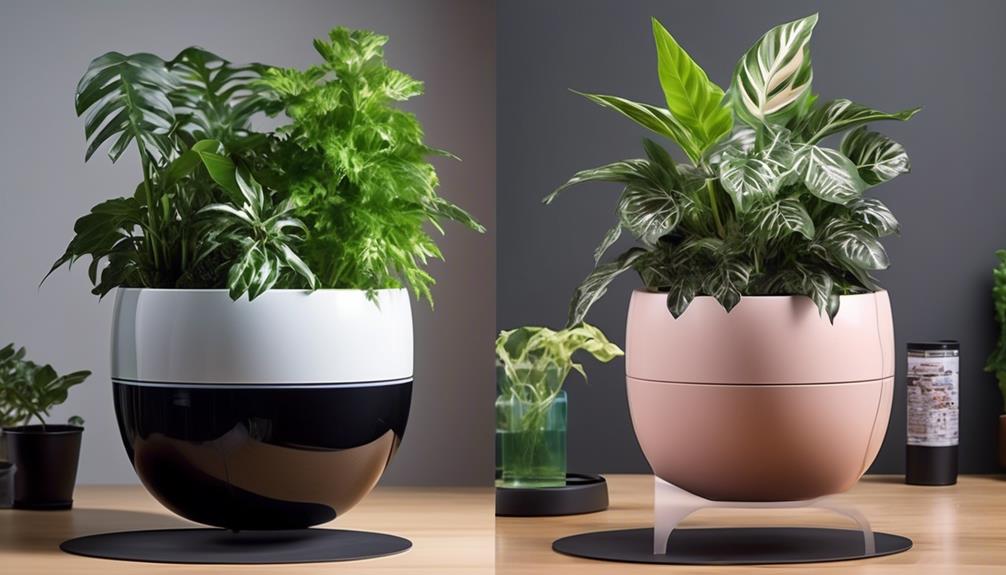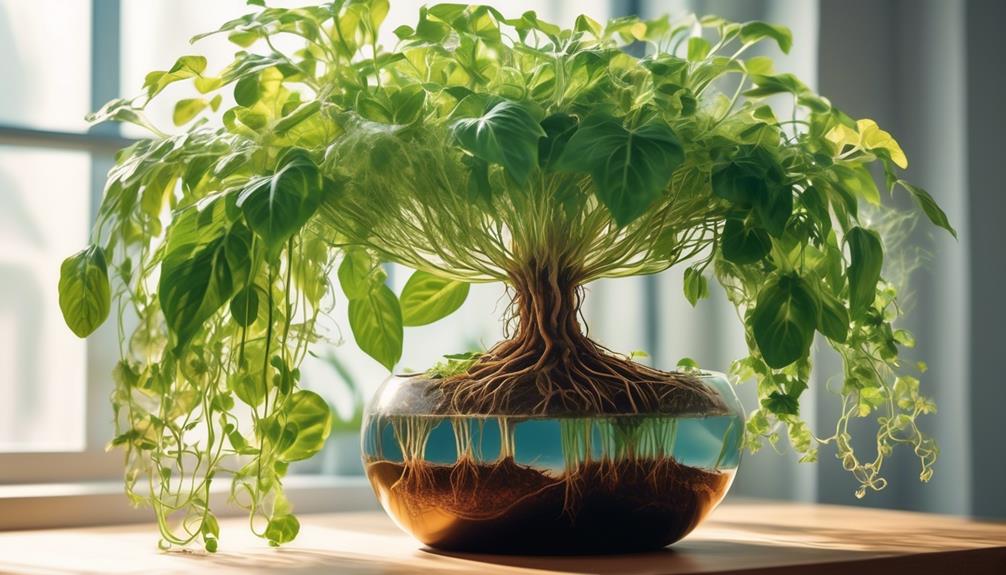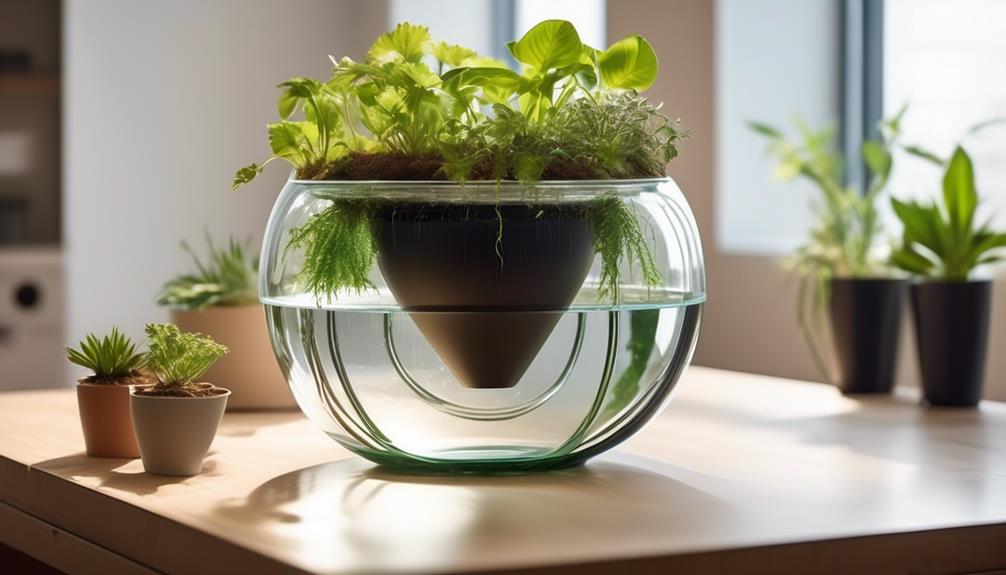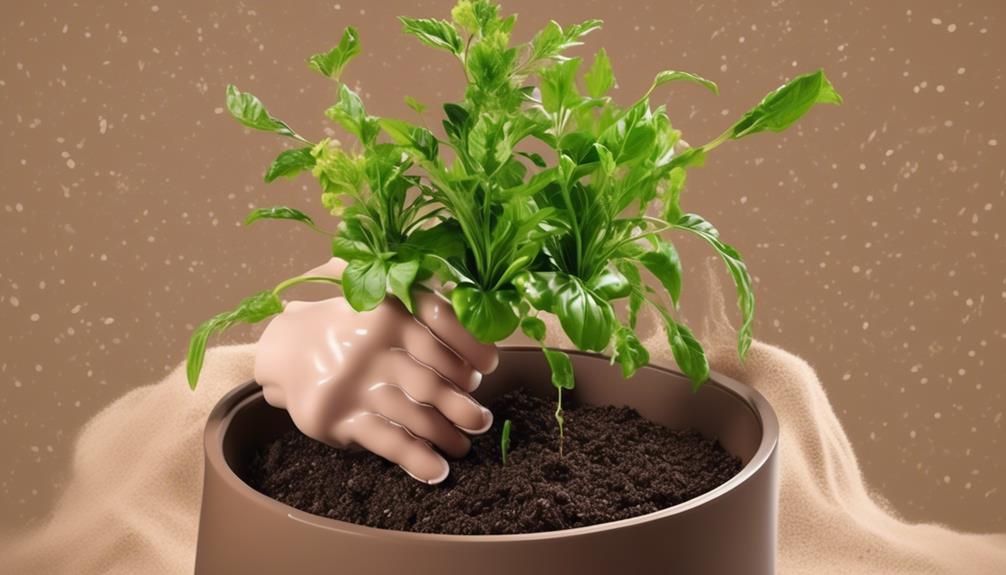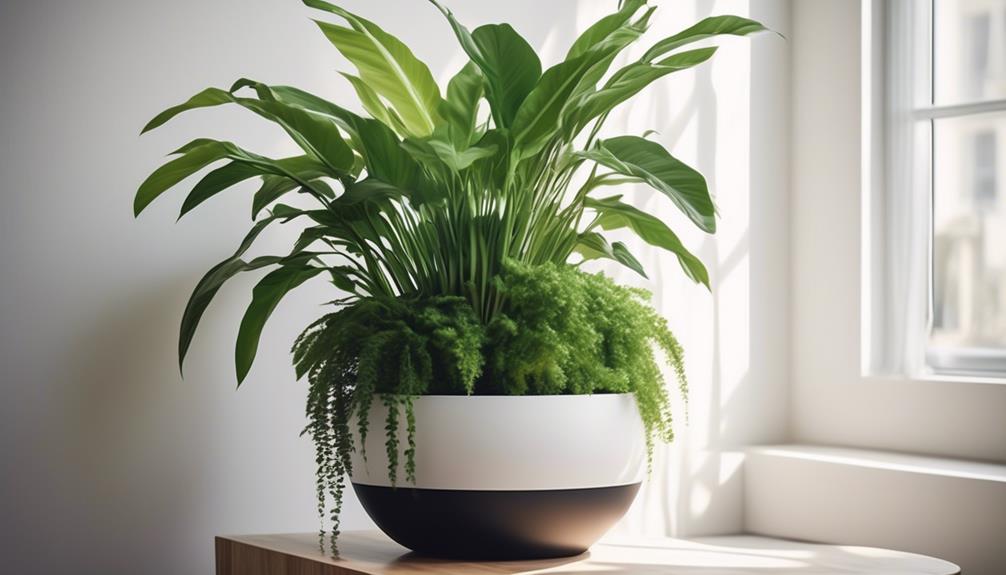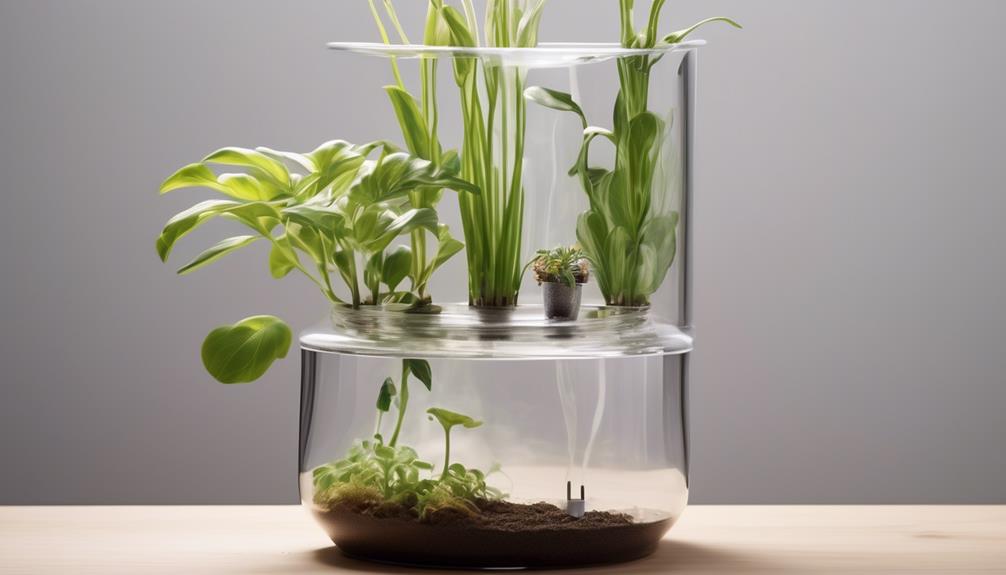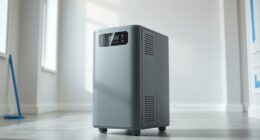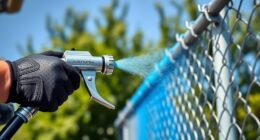Tired of always worrying about whether your plants are being watered enough?
Well, I've got just the solution for you. Amazon has a wide range of self-watering plant pots that are designed to take the guesswork out of plant care.
But before you click away, thinking, 'Oh, I've seen those before,' let me assure you that these modern self-watering pots have come a long way from the clunky designs of the past.
Stick around to find out how these innovative pots can revolutionize the way you care for your plants.
Key Takeaways
- Improved water efficiency
- Reduced risk of overwatering
- Regulates watering frequency
- Contributes to water conservation
Benefits of Self-Watering Plant Pots
The benefits of self-watering plant pots include improved water efficiency and reduced risk of overwatering, which can lead to healthier and more vibrant plants. By maintaining optimal soil moisture levels, these pots help regulate watering frequency, ensuring that plants receive the right amount of water at the right time. This is particularly beneficial for individuals who may forget to water their plants regularly or tend to overwater out of concern for plant health.
Self-watering pots utilize a reservoir system that allows the plant to draw water as needed, preventing waterlogging and root rot.
Moreover, these pots contribute to water conservation by minimizing water wastage. The design of self-watering pots also promotes capillary action, allowing the plant's roots to absorb water as necessary, promoting healthier root development. This not only enhances the overall health and longevity of the plants but also reduces the maintenance required.
The self-regulating nature of these pots makes them an excellent choice for serving the needs of busy individuals or those with a desire to ensure the well-being of their plants without constant monitoring.
Choosing the Right Size and Style
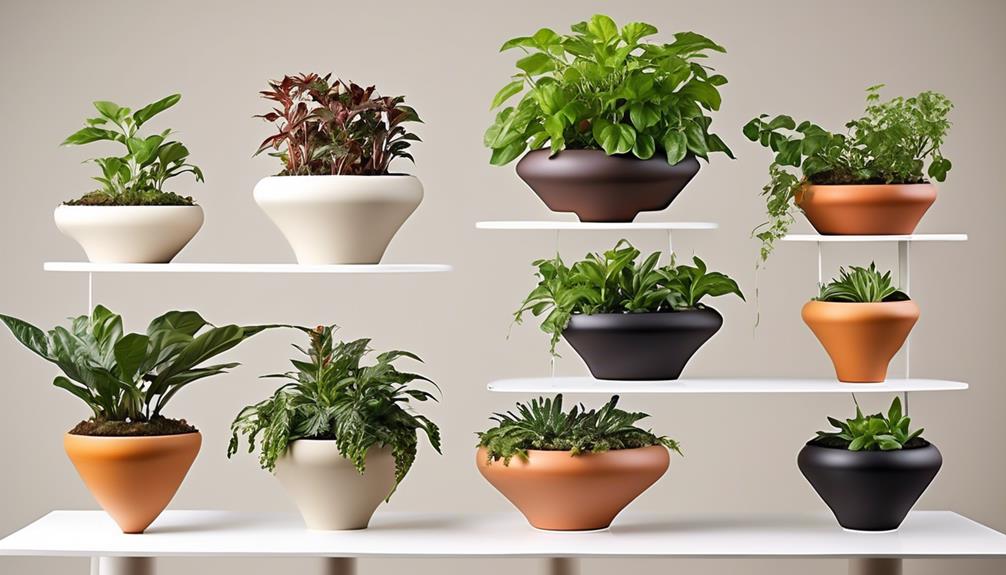
Selecting the appropriate size and style of a self-watering plant pot is crucial for ensuring optimal plant growth and water efficiency. When choosing the right size, it's important to consider the mature size of the plant, allowing enough room for the roots to grow. For smaller plants, a 6-8 inch diameter pot is usually sufficient, while larger plants may require a 10-12 inch diameter. Additionally, consider the depth of the pot, especially for plants with deep roots.
Plant pot materials play a significant role in selecting the right style. Different materials have varying insulation properties, affecting the soil temperature and moisture retention. For example, ceramic pots provide good insulation, but may require more frequent watering due to their porous nature. On the other hand, plastic pots are lightweight and retain moisture well, making them suitable for a wide range of plant types.
When matching plant types with pot styles, consider the aesthetic appeal as well as the functional aspects. For example, succulents thrive in clay or ceramic pots as they allow for better drainage, while tropical plants benefit from the moisture retention of plastic or glazed ceramic pots.
How to Set Up Self-Watering Pots
To set up self-watering pots, it is essential to first select a suitable potting mix that provides good drainage while retaining moisture for the plants' optimal growth. The potting mix should be well-aerated and have water-retaining components such as peat moss or coconut coir. Once the potting mix is chosen, follow these steps to set up the self-watering pots:
| Step | Description |
|---|---|
| Choose the Right Container | Select a container with a water reservoir and a separate planting area. |
| Add Water to the Reservoir | Fill the reservoir with water, ensuring not to overfill. |
| Monitor Watering Frequency | Check the water level regularly to gauge the watering frequency needed. |
Tips for Maintaining Healthy Plants
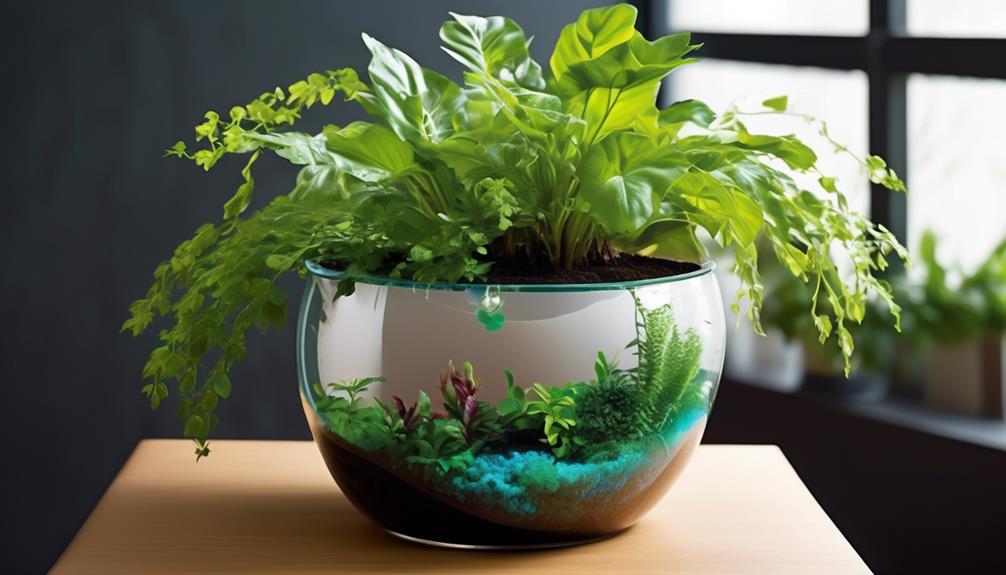
After setting up the self-watering pots with the appropriate potting mix and water reservoir, maintaining healthy plants requires diligent monitoring of the soil moisture and adjusting the watering frequency as needed. Soil moisture is crucial for plant health. We recommend checking the moisture level regularly by inserting a finger into the soil. If the soil feels dry up to the first knuckle, it's time to water. However, if it's still moist, hold off on watering to prevent over-saturation.
Sunlight exposure is equally important. Ensure that your plants receive the right amount of sunlight according to their specific needs. Too much or too little sunlight can adversely affect plant health. Observing and understanding the signs of sunlight stress in plants is essential for maintaining their well-being.
Additionally, regular pruning, proper air circulation, and keeping an eye out for pests and diseases are crucial steps in maintaining healthy plants. By following these tips and staying attentive to your plants' needs, you can ensure they thrive in their self-watering pots.
Best Amazon Self-Watering Plant Pots
We have identified several highly-rated self-watering plant pots available on Amazon that exhibit excellent water retention properties and are designed to promote optimal plant growth. When comparing different brands, it's important to consider the specific self-watering pot features that can support healthy plant growth.
Here are three top options to consider:
- Terra Cotta Self-Watering Planter:
This self-watering pot is made of porous terra cotta, which allows for air and water exchange, promoting healthy root growth. The built-in water reservoir ensures consistent moisture levels, perfect for plants that require well-drained soil.
- Ceramic Self-Watering Pot with Water Level Indicator:
This innovative pot features a water level indicator, allowing you to monitor water levels at a glance. The ceramic material provides a stable environment for plant roots, while the self-watering system prevents over or under-watering.
- Plastic Self-Watering Planter with Adjustable Air Vents:
Ideal for outdoor use, this durable plastic pot comes with adjustable air vents, providing controlled air circulation for the roots. The self-watering feature ensures plants receive water as needed, even during hot weather.
Frequently Asked Questions
Can Self-Watering Plant Pots Be Used for All Types of Plants, Including Succulents and Cacti?
Yes, self-watering plant pots can be used for a variety of plants, including succulents and cacti.
Succulent care requires well-draining soil to prevent root rot, and self-watering pots can help regulate water intake.
For cacti, proper watering is crucial, and self-watering pots can provide a consistent moisture level.
However, it's important to monitor the soil moisture to ensure it's suitable for each specific plant's needs.
Are Self-Watering Plant Pots Suitable for Indoor and Outdoor Use?
Yes, self-watering plant pots are suitable for both indoor and outdoor use. The benefits include consistent moisture levels, which can be particularly advantageous for indoor plants when humidity levels fluctuate.
However, drawbacks may include the need for occasional cleaning to prevent algae growth.
How Often Do Self-Watering Plant Pots Need to Be Refilled With Water?
We find that self-watering plant pots typically require less frequent refilling compared to traditional pots. The refilling frequency depends on factors such as plant size, type, and environmental conditions.
It's important to monitor the moisture levels to ensure proper plant hydration. Generally, self-watering pots can sustain plant hydration for several days to a week before needing a refill.
This feature makes them convenient for those seeking to maintain plant health with minimal effort.
Can Self-Watering Plant Pots Be Used With Fertilizer or Plant Food?
Yes, using fertilizers with self-watering plant pots can provide significant benefits.
Fertilizers can help enhance plant growth and health by providing essential nutrients.
When using fertilizers with self-watering pots, it's important to follow the instructions to avoid over-fertilization.
The self-watering system can help distribute the nutrients evenly, promoting healthy and vibrant plant growth.
Are There Any Special Considerations for Using Self-Watering Plant Pots in Hot or Dry Climates?
In hot or dry climates, special considerations for using self-watering plant pots include:
- Adjusting the watering frequency to account for higher evaporation rates.
- Container size is crucial to ensure sufficient soil moisture.
- Using larger pots can help retain moisture.
Monitoring the soil moisture levels is essential to prevent under or over-watering. It's important to understand the unique environmental factors in hot or dry climates to effectively maintain plant health.
Can I Find Amazon Self Watering Plant Pots at Walmart?
Yes, Walmart does have a variety of self watering plant pots in stock, including some options similar to those available on Amazon. You can find a range of sizes and styles to choose from, making it easy to find the perfect self watering plant pot for your needs.
Conclusion
In conclusion, self-watering plant pots from Amazon offer a convenient and efficient way to keep your plants healthy and thriving.
Remember, 'a watched pot never boils,' so let the self-watering system do the work for you and enjoy the benefits of flourishing greenery with minimal effort.
With the right size and style, proper setup, and regular maintenance, you can easily maintain a beautiful indoor or outdoor garden with self-watering plant pots.

